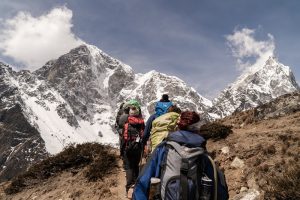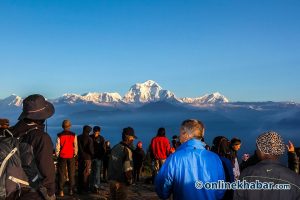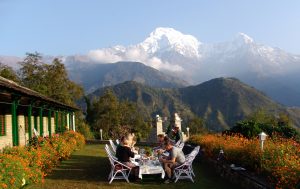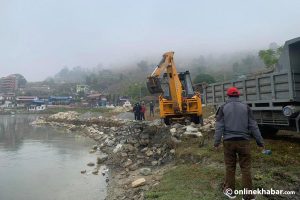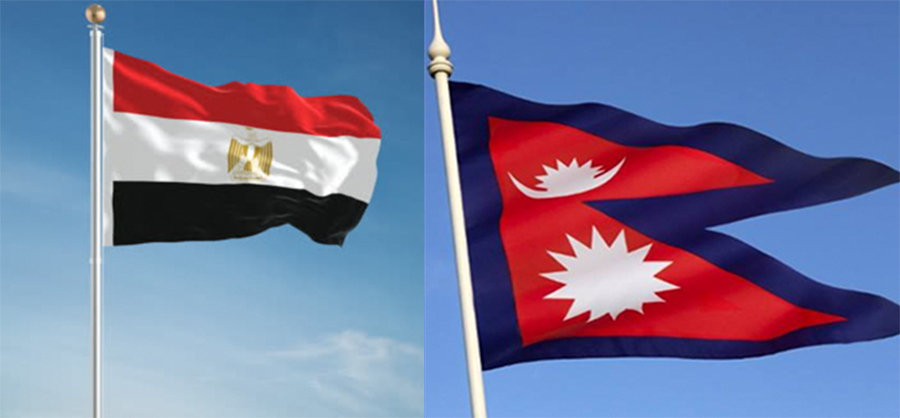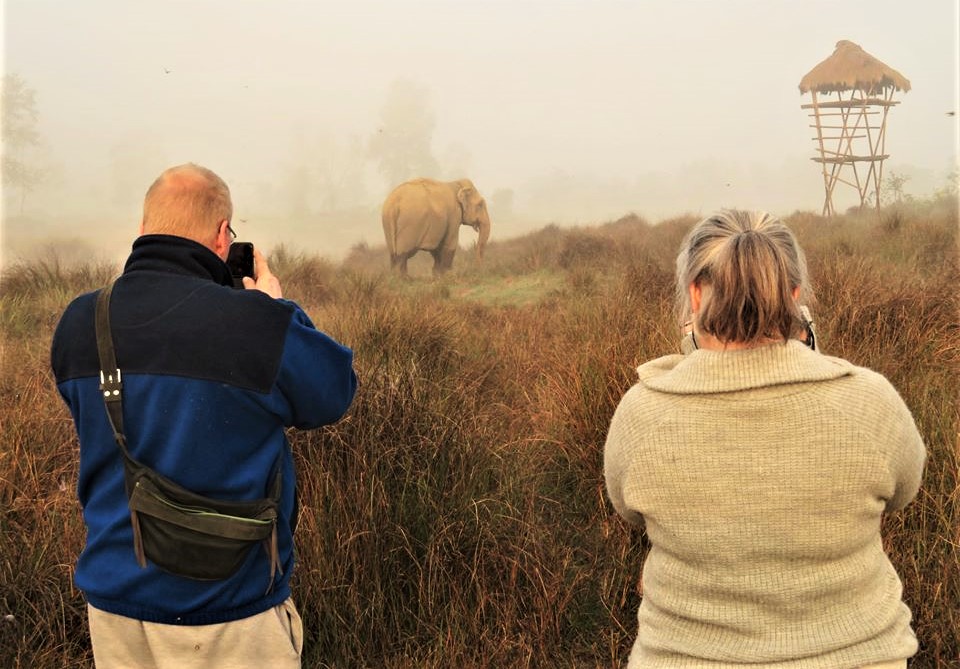
When Visit Nepal Year 2020 Secretariat coordinator Suraj Vaidya posted a short video of elephants playing football around two weeks ago, the Nepali twitterati instantly protested, claiming it promoted animal cruelty. Around the same time, dozens of international animal rights activists submitted a memorandum to the government urging it to stop the potential abuse of elephants among other animals during the ambitious tourism campaign.
These two incidents show how the stakeholders and the public want the country’s tourism to change in terms of its treatment of the animals. Whereas hundreds of Nepalis and foreigners are seen riding elephants to tour the Chitwan National Park throughout the year, there have been voices that it is a wrong idea of late.
In this context, Onlinekhabar recent talked to Lena Quénard, the founder of Association Moey, a Swiss nonprofit organisation that has been working for the rights of captive elephants of Asia. The organisation has ‘retired’ an ageing elephant from work in Chitwan and started an alternative programme to promote elephant tourism, which it says it is ethical.
Excerpts:
Why do you find it wrong to ride elephants?
Throughout Asia, it is a popular tourism activity to ride an elephant, with thousands of elephants giving rides to tourists, every day. However, an elephant’s back is not designed to carry a heavy chair with sometimes up to five people weighing over 400 kg. Abscesses and open sores can occur due to pressure from the saddle. Likewise, there could be deep wounds under the tail from the ropes that secure the saddle. All contribute to long-term physical injuries. Elephants often work long hours in the hot sun; they are not fed enough food or given sufficient water causing dehydration and exhaustion. They often walk on hot asphalt surfaces that are not good for their feet, causing painful foot injuries. They also share the roads with buses, trucks, and motorbikes, which is a safety hazard for all.
Wild elephants would not let humans ride them so an elephant must be trained to carry a chair. The training involves various painful methods which break the elephants’ spirit. They have no choice but to become subservient to humans. Nevertheless, captive elephants will always have wild tendencies and be unpredictable; their keepers (mahouts) need to reinforce the training daily.
In the wild, elephants live in large family herds for their entire lives. Separating elephants from their families and forcing them to give rides is also unnatural and cruel. Captive elephants are still wild and will always be. They remind us of this wilderness when they have an opportunity.
But still, there are thousands who find it fun to ride elephants. How can you convince them?
Awareness and education of the cruelty of riding elephants is growing around the world. Many international travel companies do not offer elephant rides anymore; tourists are now choosing more ethical elephant experiences. Bathing an elephant, even if it seems friendly and nice, remains a cruel activity under the control and domination of mahout. Many accidents can happen during this kind of activity.
But there are many ethical alternatives possible. For example, the tourists who visit Chitwan can watch how powerful Lucky Kali, the elephant that we retired, is when left to bathe on her own. When she is really enjoying herself, she slams the water with her trunk playfully and it is obvious that no tourist should be near her in moments like these.
What can those other ethical options be?
This involves seeing elephants in their natural habitat whenever possible; bathing in the river, playing in the mud, and socialising with other elephants. There is so much to learn by watching an elephant’s natural behaviours from a respectful distance. It is a peaceful and meditative experience.
Volunteering to care for elephants also can be a popular activity. The visitors can learn how to cut grass and banana trees, make kuchi (traditional food for elephants in Nepal), and get to know the mahouts and how they live.
There are so many alternatives to riding. In Nepal, elephants are used to go into the jungle for safaris to see the wildlife. The alternative to this would be to use vehicles instead.
I cannot claim to have all the answers, but I am hopeful for a positive solution based on the interest and investment of the large animal welfare organisations which are committed to doing what they can to improve the livelihood of the owners and elephants of Sauraha.
Can you please explain why and how you ‘retired’ Lucky Kali that you claim to be Nepal’s first retired elephant? What is its significance? What are its impacts?
Yes, Lucky is the first privately owned elephant to be retired from work in Sauraha.
In August 2017, she was no longer able to give rides and was due to be sold to a temple in India. In a joint effort by Association Moey and Direct Aid Nepal, we approached her owners and they agreed to lease her for our new ethical alternative project.

Thanks to the agreement of Lucky’s owners to work with us, she now lives her days with the people who are careful of her welfare and freedom. Mostly, she walks without a mahout on her back, grazes on grasses, and bathes in the river. She has a chain-free corral; when she is not in the grasslands, she is still free to roam without her legs in chains. I am so proud of Lucky’s owners for taking the risk and agreeing to trust in our idea.
When the project first began, Lucky’s feet were damaged from a long life of work. I have been giving her regular foot care ever since.
Earlier, a study of the foot problems of Nepal elephants was carried out by Dr Bablu Thakur, a scholar at the Department of Veterinary Surgery and Pharmacology in Agriculture and Forestry University, Chitwan. During that research, it was found that Lucky Kali was the only elephant to have no foot afflictions at the time of examination among the 100 elephants observed. The results are yet to be published.
Foot care and freedom are not only for physical but psychological benefits… Lucky’s wellbeing has improved greatly since she has retired, it has improved her health.
Walking on the natural substrate (grass and earth) has also resulted in the healing of her wounds, and when she walks in the grasslands, she now also naturally files her nails. Today, she is a strong, happy elephant, and a beautiful gentle soul.
An important part of her wellbeing is also having the right mahouts working with her.
What will the end to elephant riding mean to the country’s tourism business and the economy, overall?
Improving the welfare of elephants through ethical elephant tourism also means working with and improving the livelihoods of the people in Nepal. We have a holistic approach to our work. After more than two years since the project started, we have already seen positive changes already taking effect. Lucky has been staying at Sapana Village Lodge, which has its own elephants. Since Lucky has been there, the owner Dhruba Giri, could see the positive reception of the ‘Walk with Lucky’ programme. He has recently stopped offering rides with his elephants, thanks to the support of Direct Aid Nepal, which is very rewarding for me to see.
Likewise, we have been able to train mahouts ethically. We have two men, a father and his son, who are dedicated to our vision and work tirelessly with her best interests at heart. It is obvious she loves and trusts them.

We also have hired a young Nepali trekking guide, Sweta Shrestha, to work with her. She can oversee everything and lead the walks with Lucky when I am not in Nepal. These three Nepalis have become like a family to me and I am so fortunate to have them as part of my team and I am happy to be able to give them a job that they can take pride in.
Hopefully, it will be a very positive change and there will be no loss to the economy at all, just replacing one style of activity for another kinder, gentler and more lucrative version.
So what is your vision for future, in relation to elephants of Nepal?
International animal welfare groups are working on a project to have all the privately-owned elephants together in a sanctuary where the owners would receive an income.
Meanwhile, I would like to continue my efforts to inspire lodges to develop ethical activities with their elephants. I would like to take this opportunity to say that my professional team is available for assistance and guidance to anyone who wishes to start an elephant hands-off project in Nepal. We are happy to share our expertise and experience to support those who are willing to make a positive change. Lucky is a beautiful and powerful symbol of change not only for the elephants but for all the community here in Chitwan.
It is a time for the elephant owners of Nepal to make a decision about the future, but I understand they need assistance from outside. Do they want to continue to offer to ride or do they want to rise up and show the world that they can be pioneers and part of an amazing change for the captive Asian elephants?
Today, elephants are disappearing from the planet, and I have a question. How do we want to say goodbye to them: by abusing them every day or by taking the opportunity that we have, to stand up for them and do what is right?
Photos: Association Moey






